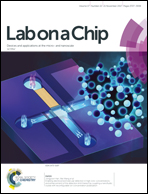Probing blood cell mechanics of hematologic processes at the single micron level†
Abstract
Blood cells circulate in a dynamic fluidic environment, and during hematologic processes such as hemostasis, thrombosis, and inflammation, blood cells interact biophysically with a myriad of vascular matrices—blood clots and the subendothelial matrix. While it is known that adherent cells physiologically respond to the mechanical properties of their underlying matrices, how blood cells interact with their mechanical microenvironment of vascular matrices remains poorly understood. To that end, we developed microfluidic systems that achieve high fidelity, high resolution, single-micron PDMS features that mimic the physical geometries of vascular matrices. With these electron beam lithography (EBL)-based microsystems, the physical interactions of individual blood cells with the mechanical properties of the matrices can be directly visualized. We observe that the physical presence of the matrix, in and of itself, mediates hematologic processes of the three major blood cell types: platelets, erythrocytes, and leukocytes. First, we find that the physical presence of single micron micropillars creates a shear microgradient that is sufficient to cause rapid, localized platelet adhesion and aggregation that leads to complete microchannel occlusion; this response is enhanced with the presence of fibrinogen or collagen on the micropillar surface. Second, we begin to describe the heretofore unknown biophysical parameters for the formation of schistocytes, pathologic erythrocyte fragments associated with various thrombotic microangiopathies (poorly understood, yet life-threatening blood disorders associated with microvascular thrombosis). Finally, we observe that the physical interactions with a vascular matrix is sufficient to cause neutrophils to form procoagulant neutrophil extracellular trap (NET)-like structures. By combining electron beam lithography (EBL), photolithography, and soft lithography, we thus create microfluidic devices that provide novel insight into the response of blood cells to the mechanical microenvironment of vascular matrices and have promise as research-enabling and diagnostic platforms.

- This article is part of the themed collections: Lab on a Chip Emerging Investigators and Lab on a Chip Pioneers of Miniaturization Lectureship winners


 Please wait while we load your content...
Please wait while we load your content...